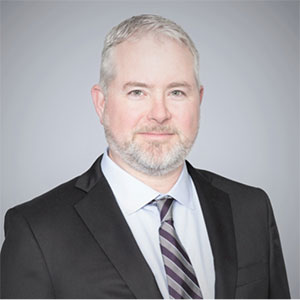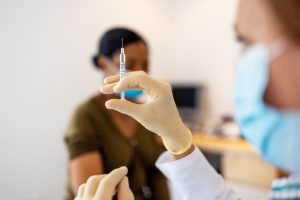Beyond Boxes and Trucks
The term “supply chain” tends to call to mind images of forklifts, trucks, or container ships at sea – but there is another, arguably more accurate, representation. Think of a supply chain as thousands of points across a line. Consider the example of buying a product online: the supply chain is the series of connections that make it possible for the new shirt, shoes, or cell phone you’ve purchased to make the sometimes long, complex journey between ‘click to buy’ and a package that shows up on your doorstep.
The risks, and the consequences, of a break in that chain grow exponentially when the added element of patient care is factored into the equation. The vast infrastructure that is the healthcare supply chain is the conveyor belt that hospitals and health systems largely depend on to supply the tens of thousands of products clinicians need to care for patients—everything from a syringe a nurse uses to draw blood at a patient’s bedside to the specially designed gloves a surgeon wears when making an incision. But the healthcare supply chain is also the lifeblood of the healthcare system, and its ability to continue beating is vital to ensuring that America’s estimated 6,000+ hospitals, outpatient care centers, and physician’s offices can care for the people who walk through their doors.
Right Product, Right Place, Right Time — And the Right People
The most important variable in connecting supply chain links that stretch from the point of manufacturing to the point of care is also perhaps the most easily overlooked. While both technology and process play vital supporting roles, the human touch is required to direct, predict, respond to, and solve the numerous logistical challenges inherent in a system with this much scope and complexity, and with so much riding on its success. In short, without the people who make it all work, there is no healthcare supply chain.
Without the people who make it all work, there is no healthcare supply chain.

Michael Darling
VP of Supply Chain
Saint Luke’s Health System
Kansas City
Michael Darling, VP of Supply Chain at Saint Luke’s Health System in Kansas City, is one such person who has developed a knack for simultaneously seeing the big picture without losing sight of the details that could impact the delivery of patient care. For him, this ability is informed by his experience working on both the clinical and supply chain sides of healthcare. Darling’s journey started in high school, when he worked at a community hospital in Atlanta in the 1970s. Later, he became a registered nurse and ultimately transitioned into a supply chain role in the 1980s. For the past four decades, Darling has navigated multiple public health crises that have strained the healthcare industry – from Ebola to COVID-19. But the AIDS crisis in the 1980s and 1990s is what really sparked Darling’s knack for building strong connections across the supply chain.
“My transition into the supply chain side of the world really came from a passion to match clinical outcomes and clinical needs with ensuring we get the right product, the right services and the right cost. When we can manage utilization, we can really control our destiny of how to deliver care to the community,” notes Darling.
Darling recalls that during the onset of the AIDS epidemic, people wanted information and answers, but there was little available. Yet despite the uncertainties, hospitals and clinicians knew that an influx of sick patients would mean the need for more supplies like personal protective equipment (PPE) to protect the health and safety of their staff. Darling’s expertise, judgment and a personal willingness to go above and beyond to prepare for more patients led him to quickly shift his team’s approach to care for these patients and continue operations across service lines.
“There’s no technology system that can make up for the experience of actually dealing with unexpected, real-world challenges in real-time.”
— Greg Hylton
Owens & Minor
Greg Hylton, VP of Supplier & Portfolio Management at Owens & Minor, has worked in the healthcare supply chain industry for nearly two decades – on the distribution side. Like Darling, in Hylton’s experience, the people who keep the healthcare supply chain moving are both vital and critical to its success.
“The healthcare supply chain counts on a lot of things to go right. Raw materials must show up, the labor force has to be in place, transportation has to be unconstrained, forecasts must be done properly, and you need the space to adequately stock supplies. What many don’t realize is that they’re also counting on the right people—who have the right partnerships and relationships, both up and down the chain—to make sure the right product gets to the right place at the right time,” says Hylton.
While technology like AI and predictive capabilities inform strategies and enhance operational excellence, listening, decision-making, and communicating are what truly deliver success, a fact that becomes even more readily apparent when unavoidable obstacles arise.
“There’s no technology system that can make up for the experience of actually dealing with unexpected, real-world challenges in real-time,” says Hylton. “It’s the people who have to look at the alternatives, who will be persistent and relentless about picking up the phone and polling within their network of industry relationships to find alternative products in stock at a local distribution center or to call the supplier and see if they can rush an order to us. Only people can drive the urgency and deliver solutions.”

Greg Hylton
General Manager, Skin Health & Specialty Solutions
Owens & Minor
The Healthcare Supply Chain in the Post-COVID Era
Ironically, for the people who support the healthcare supply chain, the best measure of success is when products appear to show up effortlessly at the point of care—leaving clinicians and patients unaware of the carefully calibrated journey something as simple as a bandage might take so that it’s on hand in the emergency room or the exam room just when it’s needed.
For Darling, the role of supply chain in healthcare is more apparent than ever given the impact the COVID-19 pandemic continues to have on the industry, and the world. “When people think supply chain, they don’t necessarily see the scope,” he says. “Our health system now has a deeper understanding of how my team touches every single service, every single location, and every single product used in our clinical network.”
Darling believes the more that health systems, distributors, manufacturers, and suppliers all speak a common language of driving positive clinical outcomes, the better the supply chain can help patients receive the care they need. But speaking starts with listening. “My job is 90 percent listening and 10 percent taking action, but taking action is based upon good knowledge and data,” he says. “Listening is more than just hearing. Listening is about what you are reading and seeing, including data inputs, from a worldwide and regional perspective.”
Darling’s point of view resonates with Hylton, who agrees that the COVID-19 pandemic dramatically increased the visibility of the healthcare supply chain, and made the need for greater collaboration, coordination, and creative problem-solving more of an imperative. In the past 40 years alone, the world has seen the emergence of HIV, SARS, MERS, H1N1, the Ebola virus, and now the ongoing COVID-19 pandemic, all of which suggest that challenges in the healthcare supply chain are inevitable, though the frequency, arrival, and magnitude may be highly uncertain.
Yet regardless of the threat future public health scares may bring, the people who connect the healthcare supply chain, who wake up each day to keep it running, will carry on, solving each problem, overcoming each logistical hurdle, breaking through each barrier thrown up by a natural catastrophe.
Because as Darling notes, the ultimate goal of a process that is so dependent on people is also, unsurprisingly, about helping people. “Increasing the ability of our providers to spend more time caring for their patients, caring for the community, and being able to focus on improving outcomes is, at the end of the day, what our job is all about.”
Note: Longtime industry veteran Michael Darling retired from Saint Luke’s Health System in January 2024.
Viral Pandemics of the Last Four Decades: Pathophysiology, Health Impacts and Perspectives. Available at https://www.ncbi.nlm.nih.gov/pmc/articles/PMC7765415/.










